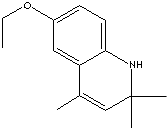| ETHOXYQUIN | ||
|
PRODUCT IDENTIFICATION |
||
| CAS NO. | 91-53-2 |
|
| EINECS NO. | 202-075-7 | |
| FORMULA | C14H19NO | |
| MOL WT. | 217.31 | |
|
H.S. CODE |
2933.40 | |
|
TOXICITY |
Oral rat LD50: 800 mg/kg |
|
| SYNONYMS | Santoquin; Santoflex; | |
| 6-Ethoxy-1,2-dihydro-2,2,4-Trimethylquinoline; EMQ; 1,2-Dihydro-6-ethoxy- 2,2,4-Trimethylquinoline; 6-Ethoxy-2,2,4-Trimethyl-1,2-Dihydroquinoline; | ||
| SMILES |
|
|
|
CLASSIFICATION |
Antioxidant | |
|
PHYSICAL AND CHEMICAL PROPERTIES |
||
| PHYSICAL STATE |
yellow to brown liquid with mercaptan-like oder |
|
| MELTING POINT | -11 C | |
| BOILING POINT |
135 - 137 C |
|
| SPECIFIC GRAVITY |
1.03 |
|
| SOLUBILITY IN WATER |
< 1 mg/ ml at 20 C |
|
| pH | ||
| VAPOR DENSITY |
7.48 |
|
|
NFPA RATINGS |
|
|
|
AUTOIGNITION |
|
|
|
REFRACTIVE INDEX |
|
|
| FLASH POINT |
107 C |
|
| STABILITY |
Stable under ordinary conditions |
|
|
APPLICATIONS |
||
| Ethoxyquin, a quinoline fungicide, is used as a growth regulator to protect
apples and pears in harvest and storage. It is also used as a color
preservative in spices. Ethoxyquin
is one of the best known feed antioxidant for pets,
domestic animal feeds and fish.
Quinoline fungicide include;
Quinoline, 1-azanaphthalene, is an aromatic nitrogen compound characterized by a double-ring structure contains a benzene fused to pyridine at two adjacent carbon atoms. (Pyridine is a ring structure compound of five carbon atoms with a nitrogen atom). Quinoline itself is the simplest member of the quinoline. It is a hygroscopic, yellowish oily liquid; slightly soluble in water, soluble alcohol, ether, carbon disulfide and readily in many organic solvents. It can be obtained by the distillation of coal tar. Quinoline can be prepared from aniline with acrolein under heated sulfuric acid (Skraup synthesis). Various quinoline compounds can be prepared by Skraup synthesis series of different oxidizing agents. Isoquinoline differs from quinoline in nitrogen position (at 2). Quinoline family compounds are widely used as a parent compound to make drugs (especially anti-malarial medicines), fungicides, biocides, alkaloids, dyes, rubber chemicals and flavoring agents. They have antiseptic, antipyretic, and antiperiodic properties. They are also used as catalyst, corrosion inhibitor, preservative, and as solvent for resins and terpenes. They are used in transition-metal complex catalyst chemistry for uniform polymerization and luminescence chemistry. They are used as antifoaming agent in refinery field. Quinaldine, 2-methylquinoline, is used as an anti-malaria and preparing other anti-malaria drugs. It is used in manufacturing oil soluble dyes, food colorants, pharmaceuticals, pH indicators and other organic compounds. Quinaldic Acid is a carboxylic acid substituted quinoline at 2 position, a catabolite of tryptophan (aromatic side chain amino acid). Quinazoline, diazanaphthalene at 1,3 positions, is used as a chemical intermediate for making medicines and other organic compounds. It is a fundamental structure in some antihypertensive agents such as prazosin and doxazosin which are peripheral vasodilator. Quinoxaline, diazanaphthalene at 1,4 positions, is used as a chemical intermediate for making fungicides and other organic compounds. |
||
| SALES SPECIFICATION | ||
|
APPEARANCE |
yellow to red-brown liquid |
|
|
ASSAY
|
95.0% min |
|
|
MELTING POINT |
-11 C |
|
|
PHENITIDINE
|
1.5% max |
|
|
ARSENIC |
3ppm max |
|
|
HEAVY METALS |
10ppm max |
|
|
SPECIFIC GRAVITY |
1.025
- 1.035
|
|
| TRANSPORTATION | ||
| PACKING |
200kgs in Drum (Liquid) , 25kgs in Bag (Powder) |
|
| HAZARD CLASS | ||
| UN NO. | ||
| OTHER INFORMATION | ||
|
|
||
